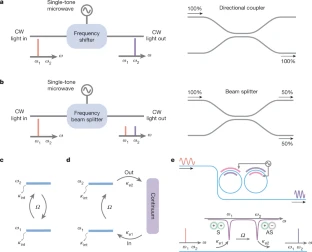Nanowerk November 24, 2021
Today, most frequency shifters are either too inefficient, losing a lot of light in the conversion process, or they can’t convert light in the gigahertz range. A team of researchers in the US (Harvard University, Caltech, industry) etched coupled ring-resonators and waveguides on thin-film lithium niobate. In the first device, two coupled resonators form a figure eight-like structure. Input light travels from the waveguide entering as one color and emerging as another. It provides frequency shifts as high as 28 gigahertz with about 90% efficiency. It can be reconfigured as tunable frequency-domain beam splitters. The second device uses three coupled resonators: a small ring resonator, a racetrack resonator, and a rectangular-shaped resonator. As light speeds around the racetrack resonator, it cascades into higher frequencies, resulting in a shift as high as 120 gigahertz. This magnitude of frequency shift was achieved using a single, 30-gigahertz microwave signal. According to the researchers their work has the potential to significantly reduce the expense and resource requirements for large-scale photonic circuits, including quantum computing, telecommunications, radar, optical signal processing and spectroscopy…read more. TECHNICAL ARTICLE

Concept of the electro-optic frequency shifter and beam splitter. Credit: Nature volume 599, pages587–593 (2021)